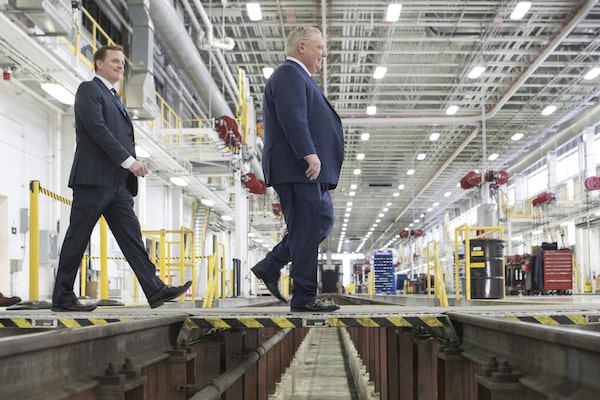
Ontario Premier Doug Ford, right, and Jeff Yurek, provincial Minister of Transportation, make their way to a photo opportunity ahead of an announcement about Ontario's transit network, in Toronto on April 10, 2019.Chris Young/The Canadian Press
The provincial government is promising to double the length of Toronto’s downtown relief line, turning it into a $10.9-billion subway connection between Ontario Place, to the west of downtown, and the Ontario Science Centre in the northeast.
Ontario Place, a provincially owned and mostly defunct amusement park next to the city’s Exhibition Place fairgrounds, had not been pegged as a subway stop on any previous city transit plan. Among those surprised at its inclusion on Mr. Ford’s map was Mayor John Tory, who found out only Wednesday morning that the subway would run there.
Premier Doug Ford, who pledged last summer to make Ontario Place into something “spectacular,” said Wednesday that his government wants to turn it into a “world-class year-round destination,” without giving details, and that better transit to the site was necessary.
Some details were unveiled Wednesday as part of a $28.5-billion transit plan for four projects, primarily in Toronto, but also extending outside the city. The province says it will be looking to other levels of government to contribute, but said it has earmarked the full amount in its capital plan.
“If need be, we’ll backstop it ourselves,” Mr. Ford said.
Ontario to announce $28.5-billion in transit funding for Greater Toronto Area
Tory says it’s time to 'push ahead and build’ two subway projects worth roughly $11-billion
King Street transit pilot working, must continue, Toronto Mayor John Tory says
The province said the relief line would be done as early as 2027. The timeline is contingent on factors including the upload of transit to the province. The announcement comes amid talks between the province and city on the Ontario government’s plan to take over ownership of Toronto’s subway network and control of expansion planning.
Mr. Tory said that even though he had been kept out of the loop on the plans, he was cautiously optimistic about the provincial announcement.
“Obviously, we need more details even than we’ve had today on that investment,” he said. “But at the end of the day, it is important to see the province of Ontario making a long-term multibillion-dollar investment in building transit in Toronto and in the GTA.”
Provincial NDP transit critic Jessica Bell said she was worried that changing plans will mean delays that affect passengers. “Doug Ford says a lot of things,” she said. “Quite frankly, I’m very skeptical. We’ve seen this before and I’m concerned that transit riders will be waiting longer.”
The concern was echoed by Toronto Councillor Brad Bradford, designated “relief-line champion” by Mr. Tory. He was skeptical of the new line’s promised faster timeline, given how long the design process normally takes: “We don’t have stations on a map. It’s just a line right now.”

The Globe and Mail
City Councillor Gord Perks also warned that the new plan would cause years of delay. He argued there was no evidence the province had done any detailed design work or sorted out the land-use planning implications of the proposed lines.
“By throwing out the existing plan, and coming up with something entirely new, Doug Ford has us chasing rainbows, and there is no pot of gold at the end of them,” he said.
Although the relief-line plan has been substantially changed, most of the government ideas announced Wednesday were variations on existing proposals.
The provincial plan calls for a new version of the Scarborough subway extension, adding two stations and stretching the line past Scarborough Town Centre to Sheppard Avenue. This is estimated to push the cost from $3.9-billion to $5.5-billion.
The project’s end-date has moved from the middle of the decade to 2029-30, according to the province. With the line that this subway is to replace on its last legs, the changed timeline would extend by several years the period when Scarborough passengers will have to rely on buses.
The other two major pieces of the plan have also been proposed before. They are a $5.6-billion extension of the Yonge subway to Richmond Hill, a project that is not slated to open until after the relief line, and a $4.7-billion extension of the Eglinton Crosstown to Pearson airport.
The proposed terminus for the relief line at Ontario Place is a new idea, though, and so is the technology being envisioned. The adapted relief line would be a lighter and smaller version of a traditional subway, similar to the Docklands Light Railway in London. It would be a stand-alone system that the province is projecting could carry 400,000 passengers a weekday.
Mr. Ford called the new version of this line, which his government is rebranding as the Ontario Line, the “crown jewel” of his transit plan. “This is a project that everyone wants to build,” he told reporters at an event in Toronto’s west end. “We’re going to deliver it by 2027.”
Instead of running from the Danforth into the city core, which the city has been studying as the first step of the relief line, the province’s version would start farther north, at Eglinton. After crossing the downtown under Queen Street, the line would veer south toward the water.
The province says it can complete this line in less than a decade, in part by going over the Don River instead of tunnelling, and in part by creating the line through a public-private partnership.
Many details are still to come, including how many stations there will be, and where. Also to be determined is how far west the line will go before dipping down to Ontario Place, and what effect this project will have on ridership at the urban GO stations the city is building under Mr. Tory’s SmartTrack plan.
 Oliver Moore
Oliver Moore